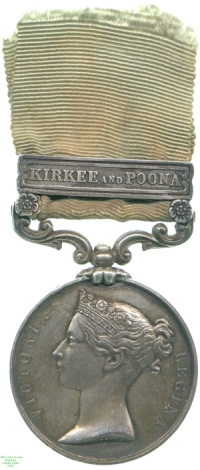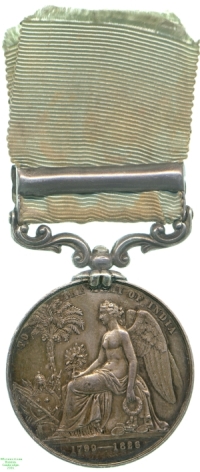
Obverse, a bust of Queen Victoria

Reverse, Victory seated facing left before a palm and war spoils, holding a laurel branch and wreath

Obverse, a bust of Queen Victoria |

Reverse, Victory seated facing left before a palm and war spoils, holding a laurel branch and wreath |
The numerous campaigns of the forces of the British East India Company were not officially recognised with a medal until 1851, in the same move as that which created the Military and Naval General Service Medals for service in the contemporary French Revolutionary and Napoleonic Wars. The resulting Army of India medal covered battles from 1799 to 1826, so many of those involved were no longer living. Queen Victoria, by whose order the medal was issued and whose bust it therefore carried, was likewise not on the throne for the actions for which it was awarded.
The Maratha Empire, a Hindu confederacy which began in 1674, had in 1796 fallen into the hands of the Peshwa ruler Baji Rao II. Repeated rebellions against his authority led him to seek help from the British, who used the opportunity to extract considerable territorial concessions. Raiding by Pindari tribesmen which resulted from this became the cause for a new war, and in 1817 British forces set out to arrest Baji Rao. The subsequent chase involved pitched battles at Kirkee and Poona in November 1817, and Baji Rao was eventually captured in 1818, and exiled on a considerable British pension which he lived to enjoy for 33 more years.
This medal is engraved to Captain J. Ford, Deputy Assistant Adjutant General, although his name is not on the Roll of those awarded the medal. Lester Watson purchased it from the dealer Gifford in 1927.